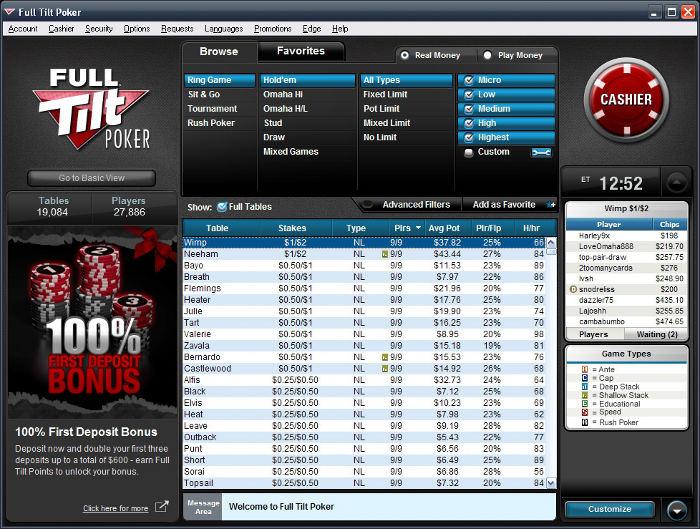Full Tilt Poker Play Online
Full Tilt was the premier place, along with PokerStars, to play cards on the internet during the poker boom era. As the company’s famous slogan went, you could “learn, chat, and play with the pros”. Online Poker Download Featuring exclusive promotions and tournament types you won't find anywhere else, we are the home of authentic poker players worldwide. Joining the tens of thousands of players who play.
While my friend and colleague Dan Katz reported earlier this week on the closure of Full Tilt Poker (occurring today), it was big enough that I felt that I needed to add onto the remembrances of the site. While many may dwell on what was the end – and the nearly nomadic existence it has had over the past decade – there was a time when the phrase “Full Tilt Poker” was one of joy. Let us take a walk down memory lane, shall we?
Do You Remember the U. S. Poker Team?
Way back in 2004, many in the U. S. were preparing for the Summer Olympics in Athens, Greece, and I was but a young(er) poker journalist. Now what do the Summer Olympics and poker have in common? One of the very first promotions for Full Tilt Poker was that they were advocating for poker to be included in the Olympics, and they took a masterful tack to build their audience.
In sending out an email to announce their “initiative” to have poker honored as an official sport at the 2004 Olympics, a company called Full Tilt Poker offered “U. S. Poker Team” hats and shirts to people who simply went to a website and gave up their email address. This masterful stroke allowed Full Tilt Poker to build an audience of poker players in general and, with the explosion of online poker, a ready database of potential players. When they launched in the summer of 2004, success was a foregone conclusion.

Many might have found the website cartoonish with its avatars, but it was just as good a poker site as the two dominant forces in the market at the time, PartyPoker and PokerStars. There was a tremendous number of games and variants offered and it offered tournaments aplenty. It was the second leg of their plan that was another masterful stroke.
As it turned out, some of the biggest names in the game had ownership in the site. Such popular pros as Howard Lederer, Chris Ferguson, Phil Ivey, Jennifer Harman and Phil Gordon (among others) made up “Team Full Tilt.” These top professionals were the stable for the site (part owners, as it came to be known) and they actively took on all comers on the virtual felt. This was unheard of! PROFESSIONAL poker players actually playing against those who wanted to be them…what a deal!
The first two years showed a slow but steady growth. They had an outstanding “relaxation area” for players during the 2005 World Series of Poker, adding to their legend. There was a memorable, ornate display in the “relaxation area” where the WSOP bracelets that members of “Team Full Tilt” had won over the years that was truly impressive. But the true growth would not come until 2006…
The “Golden Years” of Full Tilt Poker
In 2006, the Unlawful Internet Gambling Enforcement Act (UIGEA) was signed into law and Full Tilt Poker had a decision to make. Would they follow the course of publicly traded companies like 888Poker and PartyPoker and leave the U. S. market, or would they continue to service the country against the mandates of the UIGEA? Full Tilt, like the private company PokerStars, decided to stay in the country and reaped millions for the decision.
Over the course of the next five years, Full Tilt Poker went on to become the second largest online poker room behind only PokerStars. They continued to innovate in the online poker industry, bringing out more diverse poker variants that some poker rooms would not even touch (this allowed them to do mixed game tournaments). They also became the home of “high stakes” play, as Ivey and a plethora of young hotshots – including a then-unknown ‘Isildur1’ (Viktor Blom) – who would play at nosebleed levels (eight of the ten largest online poker pots in history took place at Full Tilt).
There would also be downsides for Full Tilt. Poker professional Clonie Gowen accused the ownership of wrongful termination, claiming that they offered her a 1% share in the company when she came on (Full Tilt denied this…then). They also had several lawsuits filed against them by others who had been a part of the Full Tilt family – at one point, they literally had over 100 “Friends of Full Tilt” that benefitted from the operations (and we count getting their rake back as a benefit).
The end would come quickly and suddenly, however…
“Black Friday” Destroys the Company
In April 2011, the U. S. Department of Justice dropped the hammer on the major online poker operations in the country – PokerStars, the CEREUS Network rooms Absolute Poker and UB.com, and Full Tilt Poker. While PokerStars was able to quickly negotiate a method to repay its U. S. players all monies they had on the site, the others – Full Tilt included – had not segmented their finances between being able to pay players and pay business expenses – in essence, they were using player money to fund operations, including paying their significant personnel. It may be arguable, but Full Tilt Poker was one of the worst abusers of this fact.
In court filings over the next six months, it became known that Full Tilt Poker paid the members of “Team Full Tilt” massive monthly payments from the operational funds. This included three members of its management: Lederer, Ferguson and Roy Bitar (Bitar was the only one of these three to face criminal charges). These payments left Full Tilt with no money on hand to pay players in the U. S. once the hammer was dropped by the DoJ.
Full Tilt Poker really died then, in September 2011, when they lost their operational license from the Isle of Man. Sure, PokerStars bought them in 2012 and relaunched the site, but it was but a shell of its former self. Full Tilt Poker limped along for a few more years before basically becoming a “skin” of PokerStars and not an independent operation in 2016. It has essentially existed in name only for the past five years.
Full Tilt Poker did a lot right in its time in the online poker industry. They had a “player first” feel to them that didn’t exist in another online site, as evidenced by their “Learn, Chat and Play with the Pros” tagline. But Full Tilt Poker was eventually ruined by those very pros that were responsible for its success. It is arguable that they would still be in existence today…IF they had been responsibly managed and fiscally responsible.
Requiescat in Pace, Full Tilt Poker…it was a good run.
Since it opened in June 2004, Full Tilt has been the online poker site of choice for thousands of budding poker players and professionals alike. Its excellent software, vibrant graphics, and innovative games made it extremely popular with players around the world.
Download Full Tilt Poker Game

When it first launched, Full Tilt Poker US customers were welcomed with open arms and they flocked to the site in droves for the reasons stated above, but also because the company was fronted by the likes of Howard Lederer, Chris “Jesus” Ferguson, Mike Matusow, and Phil Ivey, all of whom had become household names due to televised poker shows.
At Full Tilt Poker, USA residents could do exactly what the sites tagline suggested, “Learn, Chat and Play with the Pros,” and they did in massive numbers, helping to propel Full Tilt to second place in terms of real money cash game players, trailing only the mighty PokerStars in regards to traffic. Business was booming, tournament prize pools were swelling, and everything was rosy.
Then came what is known in the poker industry as “Black Friday.” Aptly, on Friday 13 October, 2006, the Unlawful Internet Gambling Enforcement Act of 2006 (UIEGA) came into force, which essentially made it illegal for banks and other financial institutions to process payments to gambling websites offering their services to residents of the United States.
While some online poker sites, such as partypoker, immediately withdrew from the U.S, others like PokerStars and Full Tilt continued to operate on American soil. It was a decision that paid off handsomely for PokerStars, but it was the beginning of the end for Full Tilt.

Poker sites had to be creative in order to process payments, thinking outside of the box for ways to have their players deposit and withdraw funds from the site. Unfortunately for Full Tilt Poker, US payment providers proved troublesome, which combined with some serious mismanagement by Full Tilt’s backroom staff, resulted in a huge black hole of funds.

Full Tilt Poker Play Online Games
Full Tilt continued to credit players’ account with the amounts they had attempted to deposit, but sometimes never received those funds from the payment provider. Its management team continued to do this for quite a length of time until the problem came to light and a figure of $300 million in “lost” funds was made public. This $300 million figure was what the American Department of Justice (DOJ) claimed Full Tilt had defrauded out of its customers, although former owner Chris Ferguson’s lawyer suggested the issue was most likely the result of mismanagement and not malice.
After the wheels fell off Full Tilt Poker, USA customers could no longer play on the once thriving site, in fact nobody could because Full Tilt was taken offline, seemingly lost forever, along with hundreds of millions of Full Tilt customers’ money.
US Players And Full Tilt Poker In 2015
This remained the case until July 2012 when the DOJ and PokerStars reached an agreement that saw PokerStars pay the DOJ $225 million up front and a total of $547 million. PokerStars also made $184 million available to refund all non-U.S. players within 90-days of signing the deal. Full Tilt Poker US customers are still to this day receiving their fund back from the DOJ, despite PokerStars making their balances available immediately.
On Tuesday 6 November, 2012, Full Tilt relaunched its real money operations, although Full Tilt USA was no more, the door slammed shut on them, just as it had for PokerStars’ American customers.
To this day, Full Tilt Poker US operations are non-existent, but that could be all set to change because PokerStars reentered the U.S. market on Wednesday 16 March, 2016 with a soft-launch, albeit only in the state of New Jersey. PokerStars has spent heavily in lobbying for other states to allow online poker, which if successful, could open the gates for a return of Full Tilt Poker US.
However, a full return of the original Full Tilt USA friendly site is actually unlikely because in February 2016, PokerStars announced its intentions to merge Full Tilt and PokerStars traffic during the Spring of 2016.
Although Full Tilt Poker US is no more, there are a number of alternatives for Americans wanting to play online poker in the USA. Currently, players can choose to head to 888poker, partypoker, PokerStars, and WSOP when they are in New Jersey, or WSOP.com when in the state of Nevada.
In short, Americans cannot play at Full Tilt unless they are prepared to move to a country where Full Tilt currently operates.